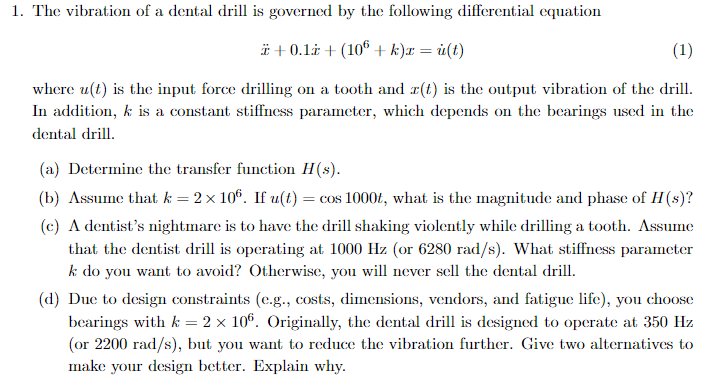1. The vibration of a dental drill is governed by the following differential equation +0.1+ (106+ k)x = u(t) (1) where u(t) is the input force drilling on a tooth and x(t) is the output vibration of the drill. In addition, k is a constant stiffness parameter, which depends on the bearings used in the dental drill. (a) Determine the transfer function H(s). (b) Assume that k = 2×106. If u(t) = cos 1000t, what is the magnitude and phase of H(s)? (c) A dentist's nightmare is to have the drill shaking violently while drilling a tooth. Assume that the dentist drill is operating at 1000 Hz (or 6280 rad/s). What stiffness parameter k do you want to avoid? Otherwise, you will never sell the dental drill. (d) Due to design constraints (e.g., costs, dimensions, vendors, and fatigue life), you choose bearings with k = 2 × 106. Originally, the dental drill is designed to operate at 350 Hz (or 2200 rad/s), but you want to reduce the vibration further. Give two alternatives to make your design better. Explain why.
1. The vibration of a dental drill is governed by the following differential equation +0.1+ (106+ k)x = u(t) (1) where u(t) is the input force drilling on a tooth and x(t) is the output vibration of the drill. In addition, k is a constant stiffness parameter, which depends on the bearings used in the dental drill. (a) Determine the transfer function H(s). (b) Assume that k = 2×106. If u(t) = cos 1000t, what is the magnitude and phase of H(s)? (c) A dentist's nightmare is to have the drill shaking violently while drilling a tooth. Assume that the dentist drill is operating at 1000 Hz (or 6280 rad/s). What stiffness parameter k do you want to avoid? Otherwise, you will never sell the dental drill. (d) Due to design constraints (e.g., costs, dimensions, vendors, and fatigue life), you choose bearings with k = 2 × 106. Originally, the dental drill is designed to operate at 350 Hz (or 2200 rad/s), but you want to reduce the vibration further. Give two alternatives to make your design better. Explain why.
Elements Of Electromagnetics
7th Edition
ISBN:9780190698614
Author:Sadiku, Matthew N. O.
Publisher:Sadiku, Matthew N. O.
ChapterMA: Math Assessment
Section: Chapter Questions
Problem 1.1MA
Question

Transcribed Image Text:1. The vibration of a dental drill is governed by the following differential equation
+0.1+ (106+ k)x = u(t)
(1)
where u(t) is the input force drilling on a tooth and x(t) is the output vibration of the drill.
In addition, k is a constant stiffness parameter, which depends on the bearings used in the
dental drill.
(a) Determine the transfer function H(s).
(b) Assume that k = 2×106. If u(t) = cos 1000t, what is the magnitude and phase of H(s)?
(c) A dentist's nightmare is to have the drill shaking violently while drilling a tooth. Assume
that the dentist drill is operating at 1000 Hz (or 6280 rad/s). What stiffness parameter
k do you want to avoid? Otherwise, you will never sell the dental drill.
(d) Due to design constraints (e.g., costs, dimensions, vendors, and fatigue life), you choose
bearings with k = 2 × 106. Originally, the dental drill is designed to operate at 350 Hz
(or 2200 rad/s), but you want to reduce the vibration further. Give two alternatives to
make your design better. Explain why.
Expert Solution
This question has been solved!
Explore an expertly crafted, step-by-step solution for a thorough understanding of key concepts.
Step by step
Solved in 2 steps

Recommended textbooks for you

Elements Of Electromagnetics
Mechanical Engineering
ISBN:
9780190698614
Author:
Sadiku, Matthew N. O.
Publisher:
Oxford University Press

Mechanics of Materials (10th Edition)
Mechanical Engineering
ISBN:
9780134319650
Author:
Russell C. Hibbeler
Publisher:
PEARSON

Thermodynamics: An Engineering Approach
Mechanical Engineering
ISBN:
9781259822674
Author:
Yunus A. Cengel Dr., Michael A. Boles
Publisher:
McGraw-Hill Education

Elements Of Electromagnetics
Mechanical Engineering
ISBN:
9780190698614
Author:
Sadiku, Matthew N. O.
Publisher:
Oxford University Press

Mechanics of Materials (10th Edition)
Mechanical Engineering
ISBN:
9780134319650
Author:
Russell C. Hibbeler
Publisher:
PEARSON

Thermodynamics: An Engineering Approach
Mechanical Engineering
ISBN:
9781259822674
Author:
Yunus A. Cengel Dr., Michael A. Boles
Publisher:
McGraw-Hill Education

Control Systems Engineering
Mechanical Engineering
ISBN:
9781118170519
Author:
Norman S. Nise
Publisher:
WILEY

Mechanics of Materials (MindTap Course List)
Mechanical Engineering
ISBN:
9781337093347
Author:
Barry J. Goodno, James M. Gere
Publisher:
Cengage Learning

Engineering Mechanics: Statics
Mechanical Engineering
ISBN:
9781118807330
Author:
James L. Meriam, L. G. Kraige, J. N. Bolton
Publisher:
WILEY